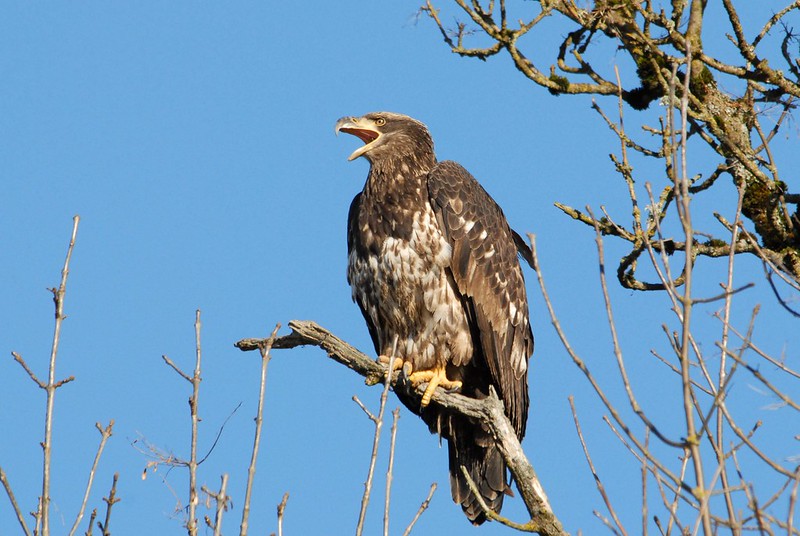
The Majestic Baby Eagle: A Symbol of Strength and Resilience
In the realm of avian wonders, the baby eagle stands as a captivating embodiment of strength, resilience, and the indomitable spirit of nature. These magnificent creatures, with their piercing gaze and formidable presence, have long captivated the human imagination, inspiring awe and admiration.
Birth and Early Development
Baby eagles, known as eaglets, are born after an incubation period of approximately 35 days. They emerge from their eggs as helpless and vulnerable hatchlings, covered in soft, downy feathers. The eaglets are entirely dependent on their parents for food, warmth, and protection.
During the first few weeks of life, the eaglets grow rapidly, their bodies developing the strength and agility necessary for their future aerial adventures. Their feathers begin to take shape, gradually replacing the downy plumage.
Parental Care
Eagle parents exhibit exceptional devotion to their young. Both the male and female eagles share the responsibilities of feeding, protecting, and nurturing the eaglets. They tirelessly hunt for prey, bringing back food to the nest for their hungry brood.
The parents also provide warmth and comfort to the eaglets, shielding them from the elements and predators. They use their powerful wings to create a protective canopy over the nest, ensuring the safety of their offspring.
Learning to Fly
As the eaglets mature, they begin to develop the skills necessary for flight. They flap their wings vigorously, strengthening their muscles and gaining confidence. The parents encourage their young to venture outside the nest, offering support and guidance as they take their first tentative steps into the air.
The initial flights are often clumsy and awkward, but with each attempt, the eaglets gain experience and coordination. They soar higher and farther, exploring the vast expanse of their surroundings.
Independence and Maturity
After several months of parental care, the eaglets become increasingly independent. They begin to hunt for their own food and establish their own territories. The bond between the parents and their offspring gradually weakens as the eaglets reach maturity.
At around two years of age, the eaglets are fully mature and ready to start their own families. They will continue to grow in size and strength throughout their lives, reaching their peak physical condition at around five years of age.
Physical Characteristics
Baby eagles are characterized by their distinctive physical features. They have large, piercing eyes that can detect prey from great distances. Their beaks are sharp and powerful, capable of tearing through flesh.
Their wings are long and broad, providing them with exceptional lift and maneuverability. The feathers on their bodies are a combination of brown and white, offering camouflage in their natural habitats.
Habitat and Distribution
Eagles are found in a wide range of habitats around the world, including forests, mountains, and coastal areas. They prefer areas with open spaces for hunting and nesting.
Different species of eagles have specific habitat preferences. For example, bald eagles are commonly found near bodies of water, while golden eagles prefer mountainous regions.
Diet and Hunting
Eagles are apex predators, occupying the top of the food chain. They primarily feed on fish, small mammals, birds, and reptiles. Their hunting techniques vary depending on the species and the availability of prey.
Some eagles, such as bald eagles, are skilled at catching fish from the water. They use their sharp talons to snatch their prey from the surface or dive deep into the water to pursue it.
Other eagles, like golden eagles, are adept at hunting on land. They soar high above the ground, scanning for potential prey. When they spot a target, they swoop down with incredible speed and precision.
Conservation Status
Eagles face various threats to their survival, including habitat loss, pollution, and illegal hunting. Some species, such as the bald eagle, have been successfully recovered from the brink of extinction through conservation efforts.
However, other species, such as the Philippine eagle, remain critically endangered due to habitat destruction and poaching. Conservation organizations are working to protect eagle populations and ensure their long-term survival.
Cultural Significance
Eagles have held a profound cultural significance throughout history. They have been revered as symbols of strength, courage, and freedom in many cultures.
In ancient Rome, the eagle was the symbol of the Roman Empire and was associated with the god Jupiter. In the United States, the bald eagle is the national bird and represents the country’s ideals of liberty and independence.
Conclusion
The baby eagle is a testament to the wonders of nature. Its journey from a helpless hatchling to a majestic predator is a story of resilience, determination, and the unwavering support of its parents.
As symbols of strength and freedom, eagles continue to inspire awe and admiration in humans. Their presence in our world reminds us of the importance of conservation and the interconnectedness of all living things.
